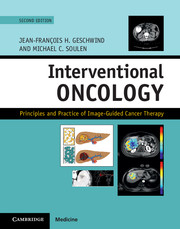Book contents
- Frontmatter
- Contents
- List of contributors
- Section I Principles of oncology
- Section II Principles of image-guided therapies
- Section III Organ-specific cancers – primary liver cancers
- Section IV Organ-specific cancers – liver metastases
- Section V Organ-specific cancers – extrahepatic biliary cancer
- Section VI Organ-specific cancers – renal cell carcinoma
- 22 Management of small renal masses
- 23 Embolotherapy in the management of renal cell carcinoma
- Section VII Organ-specific cancers – chest
- Section VIII Organ-specific cancers – musculoskeletal
- Section IX Organ-specific cancers – prostate
- Section X Specialized interventional techniques in cancer care
- Index
- References
22 - Management of small renal masses
from Section VI - Organ-specific cancers – renal cell carcinoma
Published online by Cambridge University Press: 05 September 2016
- Frontmatter
- Contents
- List of contributors
- Section I Principles of oncology
- Section II Principles of image-guided therapies
- Section III Organ-specific cancers – primary liver cancers
- Section IV Organ-specific cancers – liver metastases
- Section V Organ-specific cancers – extrahepatic biliary cancer
- Section VI Organ-specific cancers – renal cell carcinoma
- 22 Management of small renal masses
- 23 Embolotherapy in the management of renal cell carcinoma
- Section VII Organ-specific cancers – chest
- Section VIII Organ-specific cancers – musculoskeletal
- Section IX Organ-specific cancers – prostate
- Section X Specialized interventional techniques in cancer care
- Index
- References
Summary
Approximately 61,560 new cases of renal cell carcinoma (RCC) were estimated to be diagnosed in the USA in 2015, with 14,080 cancer-related deaths attributed to cancers of the kidneys and the renal pelvis. More than one-half of these patients were diagnosed incidentally on cross-sectional imaging performed for non-related conditions. Increased incidental detection of small renal masses as well as advances in surgical techniques have led to development of nephron-sparing procedures for treatment in order to preserve renal function. Over the past decade, the options for the treatment of RCC have evolved to include radical nephrectomy as well as partial nephrectomy, laparoscopic nephrectomy and, in selected cases, percutaneous radiofrequency ablation (RFA), microwave ablation (MWA), and cryotherapy. Each therapy has unique clinical applications and benefits. This article illustrates various treatment modalities used in the therapy of RCC, with special emphasis on percutaneous ablative techniques.
Clinical overview
RCC accounts for 85% of all renal tumors and is slightly more common in men than in women (1.6:1.0). Symptomatic RCC usually presents with a triad of flank pain, hematuria, and a palpable abdominal mass. Hematuria, either gross or microscopic, in any patient usually warrants evaluation by a computed tomographic (CT) scan. Other non-specific symptoms include weight loss, anemia, or fatigue. However, almost one-half of patients are asymptomatic at diagnosis and have incidentally detected tumors on cross-sectional imaging. Certain genetic syndromes such as von Hippel–Lindau (VHL) disease increase the incidence of RCC (accounting for approximately 2% of cases of RCC). Other risk factors include smoking, hypertension, obesity, and end-stage renal disease resulting in dialysis.
Clear-cell RCC is the most common histological subtype and is associated with VHL syndrome and end-stage renal disease (Table 22.1). Other inherited forms include familial clear-cell RCC. Papillary RCC, when sporadic, has a prominent male preponderance and is associated with almost 90% 5-year survival rates prior to metastatic spread. Papillary RCC has a lesser incidence of metastases than clear-cell but, when metastatic, is harder to treat. Papillary RCC is also seen in end-stage renal disease and in several familial syndromes. Other less common cell types include chromophobe RCC and collecting-duct RCC.
- Type
- Chapter
- Information
- Interventional OncologyPrinciples and Practice of Image-Guided Cancer Therapy, pp. 203 - 213Publisher: Cambridge University PressPrint publication year: 2016

